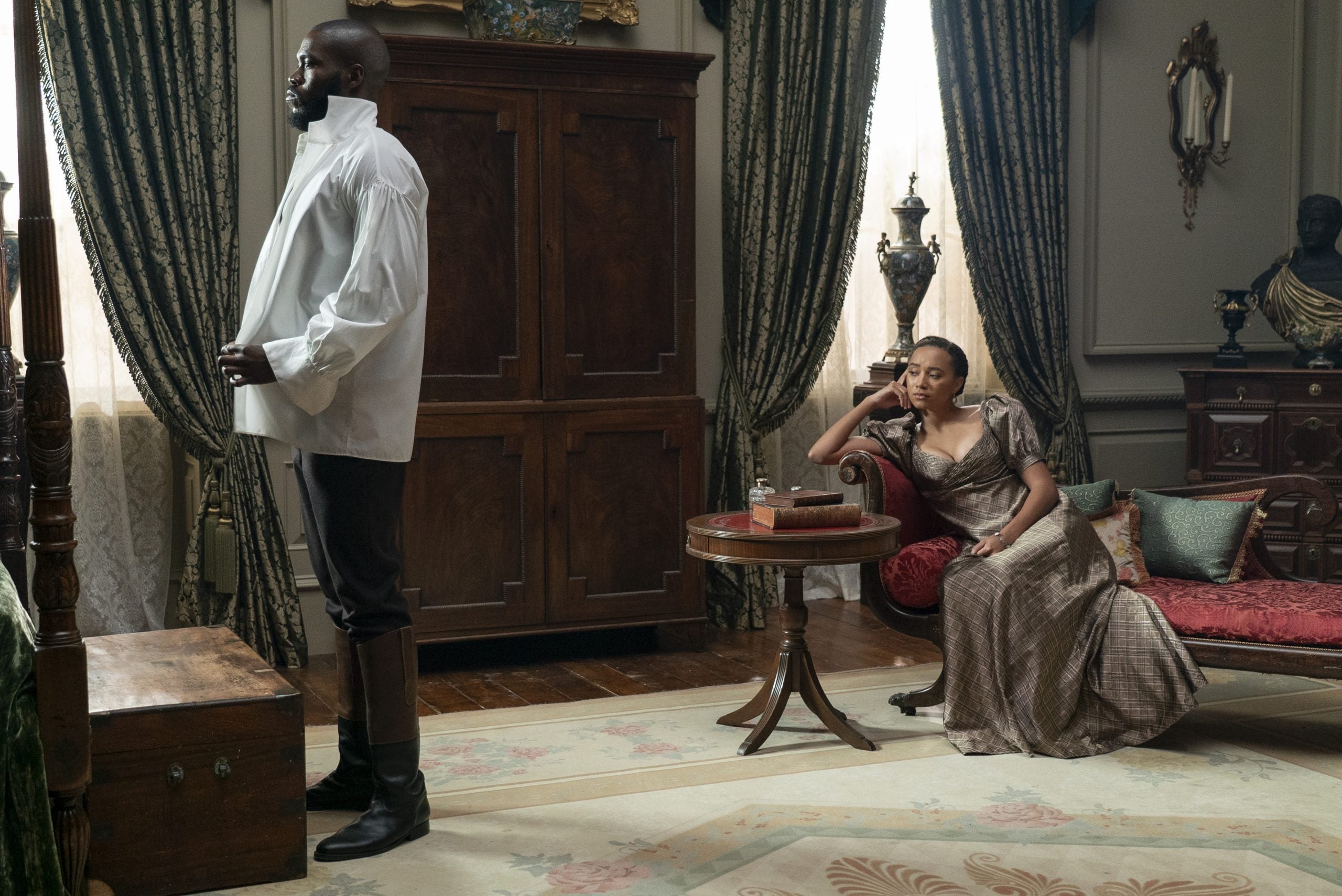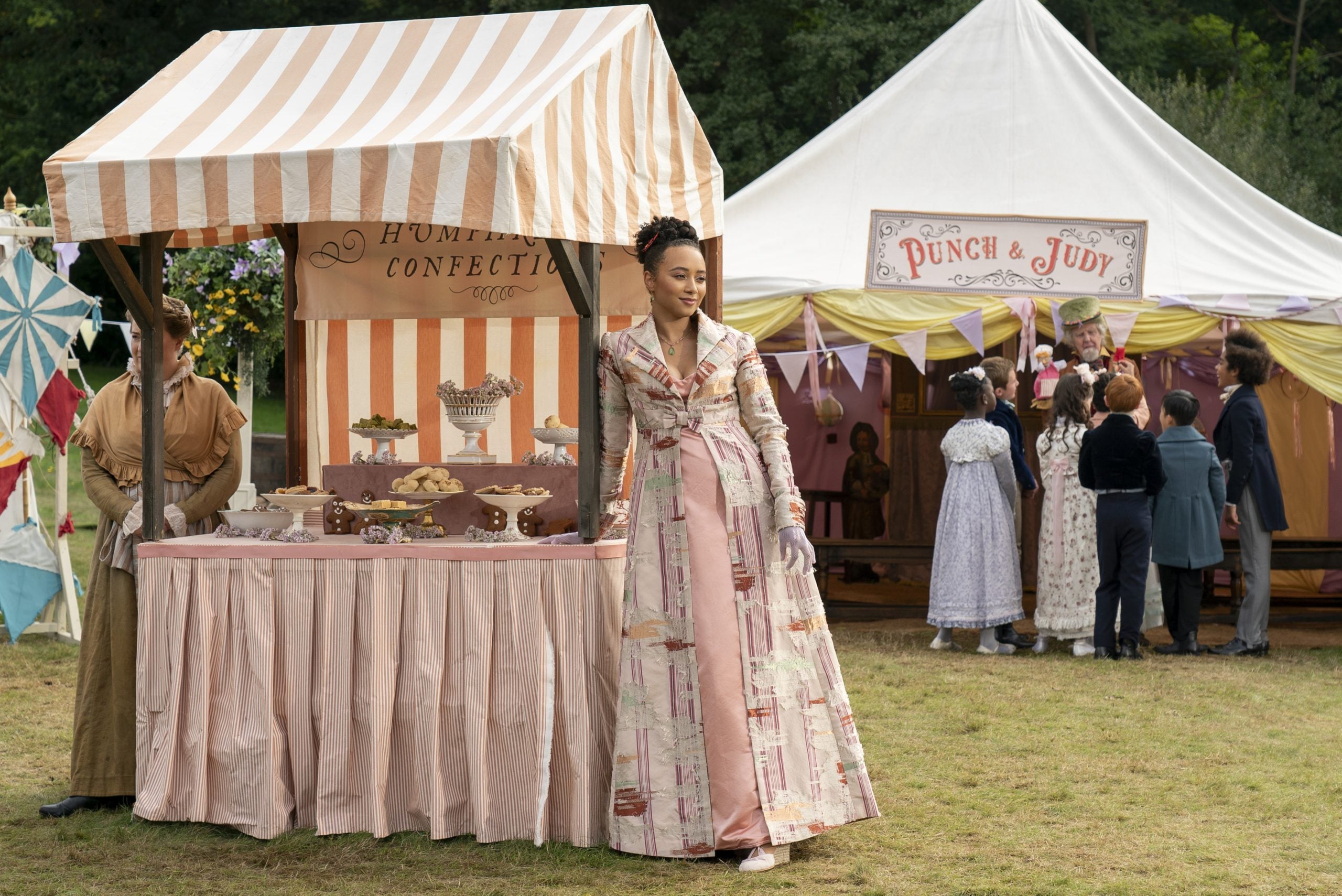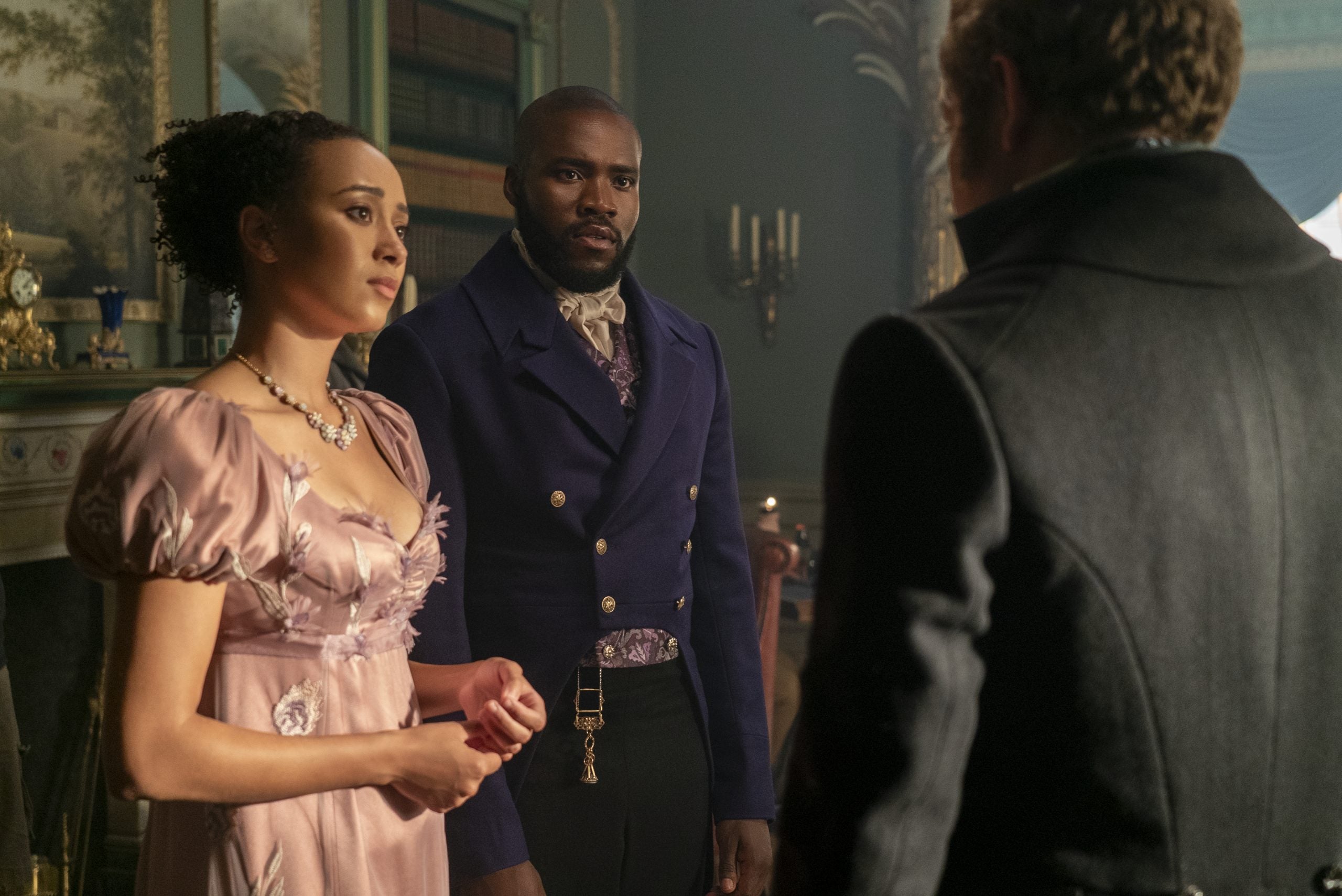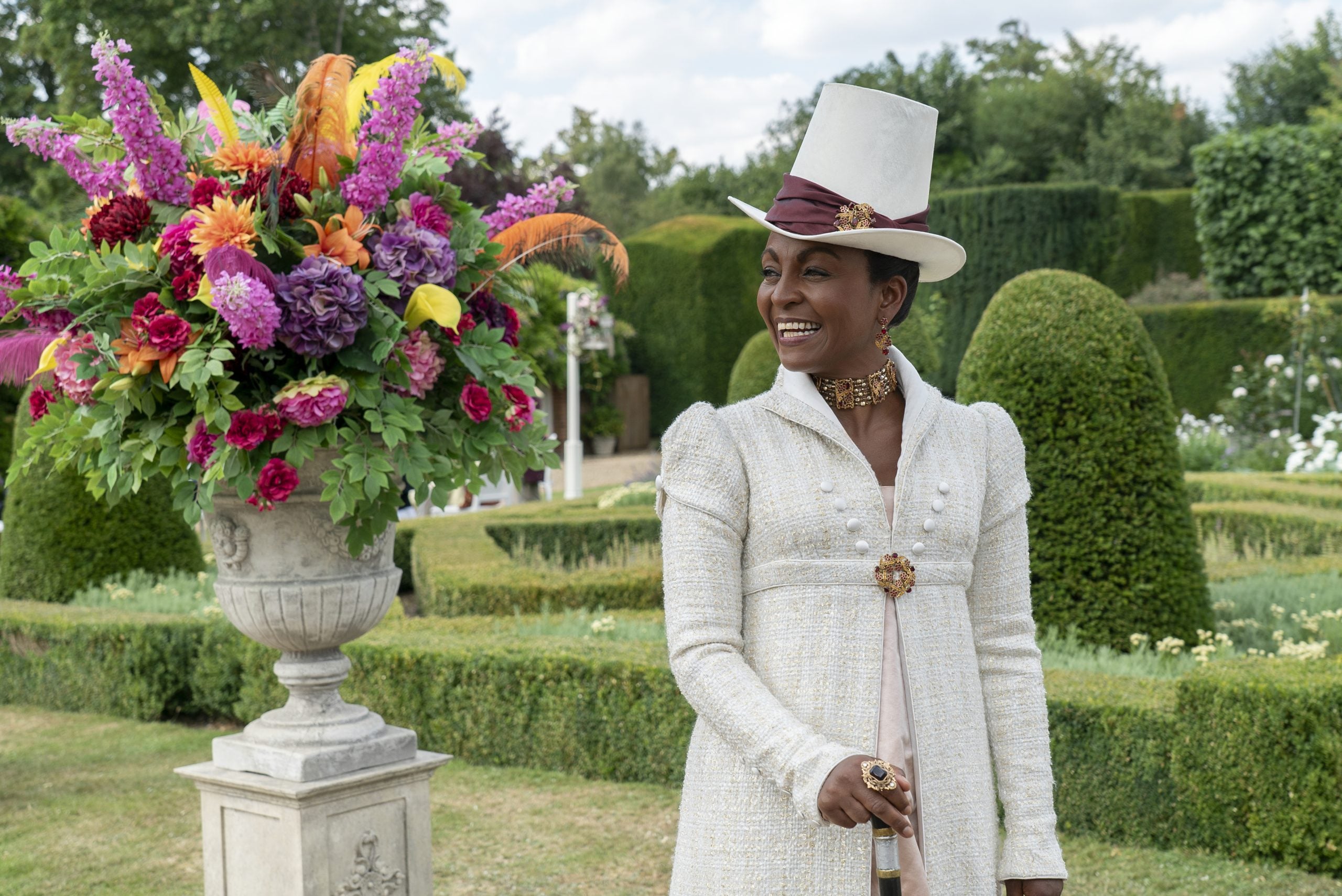
This season, the tides are changing for the Mondrichs, a Black fictional family in the Bridgerton universe. Comprised of Will (Martins Imhangbe), a former boxer, Alice (Emma Naomi), and their three children, amid the Regency era it’s poignant that each of them is recurring in the series. This family is rising in the ranks due to the ingenuity and business savvy of Will–but also due to Alice’s ability to keep him focused. He’s risen from being a successful boxer to the owner of a gentleman’s club. Bridgerton has never shied away from showcasing the highs and lows of Will’s entrepreneurial pursuits–it makes for compelling television. It also offers a respite from the drama in the town: Queen Charlotte’s reign, the writings of Lady Whistledown, Lady Danbury’s affinity for the young women seeking to be married, and the Bridgerton family’s daily ruminations.
In matters of style, each family has a key color palette, says John Glaser, the costume designer for the series’ third season. Glaser has been a part of the series since its debut season alongside Ellen Mirojnick. The Mondrichs who have had a bit of a plain wardrobe in previous seasons in particular stumble upon a fortune that is bespoken to their eldest son–and so the ante is heightened for them, especially Alice. The tones associated with this family are currently rich whites, light blue, and also even red. Since the Regency era is a time period where overlays, embellishments, and dramatic details were the norm, the Mondrichs leaned into this.

“A person like Alice, her first dresses were simple,” says Glaser. “Then we see the old lady’s dresses [from her late relative].” He also notes that she could’ve taken a step into being gaudy or over the top to show her position. But, instead, he and the design team decided to elevate things a smidgen. He feels her character wouldn’t have wanted a completely different wardrobe, however, new dresses and gowns are created to address her newly minted moneyed status.
Glaser expresses that in this season of Bridgerton which takes place in 1813, they’ve pushed Alice’s wardrobe into 1820. “She has a slightly different look than everyone else,” he says. “You really don’t notice it because it still has to blend in with everyone.” Their reasoning for doing so is to further signify her confidence in her new stature in the ton. She is no longer holding onto previous messaging about her life and status–Alice is ushering in a new era. “She’s got the money, she has the position. She has a great husband. She has a great family. I think she feels secure in her life,” Glaser shares.
A striking and somewhat vivacious gown with red dots throughout, which she wears to one ball, further encapsulates Alice Mondrich’s sartorial elevation. A white Grecian-inspired gown she dons while sitting alongside Queen Charlotte is yet another departure from her original wardrobe that showcases her wealth. It’s evident that through these ensembles, she is embracing what life has thrown her way, a fitting and deserving change in luck. Glaser notes that the red-centric gown sets the tone for what we see her wearing for the rest of the season. Below, we caught up with John Glaser, Bridgerton’s costume designer, to discuss the creation of the Mondrichs’ wardrobe, what to expect this season, and the design cues he and his team utilized.

One scene I think of specifically when I think of the elevation of the style of the Mondrich family is when Alice is trying on new clothes in her new dressing room. Can you break down this moment?
What I liked about that scene is that when she’s at the modiste, she’s wearing something that was in the attic that was owned by someone else and it’s completely over the top. But because it’s for an older lady, it doesn’t suit her. And even with the subtle changes that the modiste makes to make it work for her, it’s part of the show that works, I think rather well because she’s still not comfortable in her new position. But after that situation, she realizes the opportunity that she has and goes with it.
I liked the fact that we were able to give her a new look that’s a little different than anyone else and completely different from the old lady’s dress in the attic and different even from how Alice looked originally
What details can you share about the red gown Alice wears to a ball especially since it’s somewhat a pivotal moment for her in Season 3?
That look is really [pivotal] because it’s one time that we know that the camera will shoot from the floor to the ceiling, and again, it was an opportunity. This is the first time that she’s out in society. I’ve said this before, it’s a time when a costume designer could have done something flamboyant, over the top that the audience would see the dress, but they wouldn’t see the character. It would hinder the scene. And I feel that dress sets the tone for the rest of Alice’s wardrobe that we see. We also used a color that was very complimentary with her skin so that the costume, the actor, and the character kind of blend together.
Are there specific design details you and your team wanted to key in on for Will this season?
Will made a big transformation from when he was a boxer to when he owned, now he owns the club. He as a man will not change as much as she will. He’s also a very well-developed and formed man. So you don’t have to do very much. You have to keep him simple. There’s no way to put a cherry on top of him. Do you know what I mean? It’s like he could wear a garbage bag and look great. So we keep him simple.
Also, he can’t become too flamboyant because he’s still not confident in what’s happening to his family. He doesn’t become the heir, his son becomes the heir. And I think he’s struggling with that. It’s interesting because he’s so masculine, that he’s having some issues with masculinity.

With Alice’s characterization this season and the costuming, are you hopeful that it comes across that she’s confident and she’s excited about this next chapter?
Yes, she embraces her new situation and her clothing becomes more elegant and more sophisticated. And you’ll see that evolution. She [also] doesn’t want to show off. She doesn’t want to be gaudy. She doesn’t want to be out of place, but she has a lot of taste, which you’ll see.
I think it’s just exciting seeing Alice wearing things that are similar to some of the other women in the show, like Lady Danbury, and some of the other lead characters. What were you inspired by when you were piecing together everything?
The elevation is a natural progression because [in] season one we didn’t know the families. We didn’t know the audience. We had to show the audience who each family was. That’s why each family has a color, a palette. Season two became a little more period-oriented and not as fashion-oriented because of the story.
In season three, we felt that the audience had seen 16 episodes, but they knew the characteristics. They’ve watched the show, and we didn’t have to hold to that color palette as much as we did before, which allows what you call the elevation because now we can expand our colors, we can expand our textures, we can help to enhance the characters without using certain colors that aren’t correct for them. So we were able to design things that were more in tune with the actual person and the character that they were showing us.
Can you share a bit about Lady Danbury’s costume design this season too? Adjoa Andoh who plays her is always a bit more covered than other characters.
Her character [is] covered because we played her a little masculine, but you’ll find out that she, in this season, she maintains that iconic look of Lady Danbury, the burgundy. But we’ve expanded her silhouette where we see her shoulders. She’s much more open and free when she’s at a ball. And that too, again, is because the story has matured, the characters have matured. So the time has now allowed us to expose a little more of her other characteristics, not just the one iconic character that we think of.

What silhouettes and design decisions were you and your team aiming to convey about the lead character Penelope Featherington this season? She shifted a bit away from the bright color palette of her family.
Because her mother always made her wear the bright yellows–now [that] she’s got her own money and she’s moving away from the family–she wanted to present herself. We thought [we’d] do everything that she’s never worn. She’s never worn black, like the black gloves. She’s never really worn things that sparkle. She’s never worn that dark of a color green. And if you look at that dress, the fabric that’s under it that is shiny is green and copper. Then the copper is [mixed] in with her hair, so she becomes one cohesive unit. But in that scene, as you know, it doesn’t go so well because of Cressida. So she’s shown herself.
She’s no longer the wallflower. So because she is the leading lady, we dropped her colors, which you see, which are much more subtle, and they’re made up of layers of fabrics that are blue, greens, pink so that we’re not giving away Easter eggs as to where she’s going.
And when you look at the dresses, you’re not really sure what color they are. They could be blue, they could be green. And we also, previously, the Regency’s silhouette doesn’t show the shape of the person’s body or the form. And it was now because she was more mature that we needed to take her from a child to a woman.
[In] the modiste, [her and Madame Genevieve Delacroix] talk about Paris. So we’ve pushed her a little bit into 1817, and we’ve actually looked at that [time] and thought about Hollywood glamour, and you see her hair looks like a Hollywood movie star from the 1940s. And so we placed her shape into Marilyn Monroe, has a great shape because she has matured, but we took her colors down so that she could also still be the wallflower.
She could still be the observer. And because she’s on camera so much, she’s the leading lady, we didn’t want to overwhelm her with bright colors and clothing, and we wanted her character to shine through.
What led to the switch-up of Alice’s clothing aside from her new status?
Because now she has money–she’s sophisticated, she has taste, and she has confidence because she no longer has anything to prove. She’s got the money, she has the position. She has a great husband. She has a great family. I think she feels secure in her life. She may not feel secure yet in the town, but her clothes don’t reveal that she has any inhibitions or she’s weak in any way. And there’s a scene where she’s sitting with the Queen, right next to the Queen, which is a big step.







